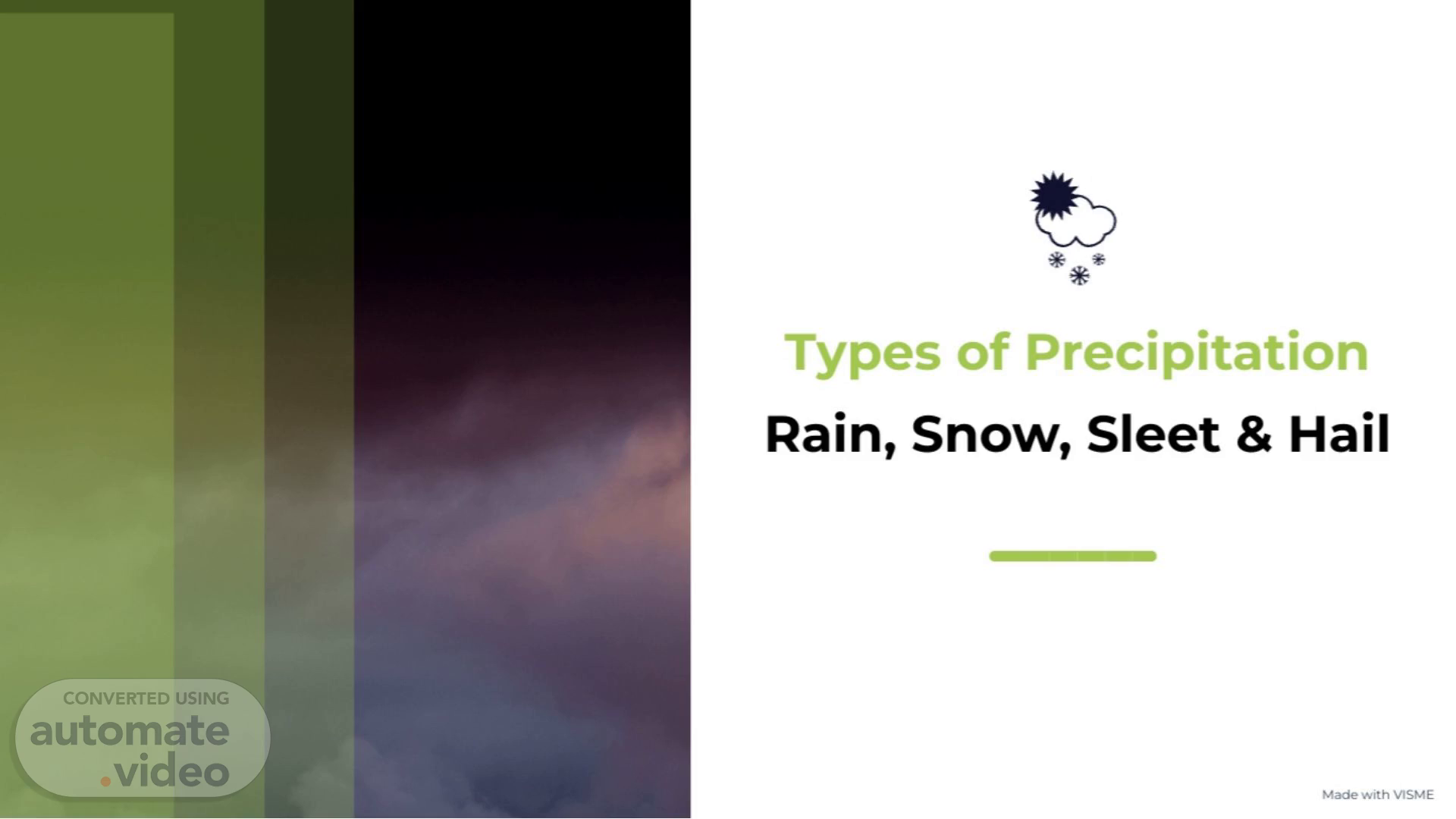Scene 1 (0s)
Types of Precipitation Rain, Snow, Sleet & Hail Made with VISME.
Scene 2 (7s)
The SNOW Ice crystak o' that remain frozen from cloud to surface. produ:ing flakes with cryst a Iline shapes four main types of precipitation MIXED Conditions Where or together or raindrogz freeze ort contact. creatir•g glaze or freezing rain hazards Layered bans or lumps o' ice formed inside *rong thunderstorm can large regeared cycles through freezing regions. Partia»y rnened snow or raindrops that refreeze into vna.ll ice pellets Erfore reaching the grour•d, often ing shallow coki layers. Liquid water droplets that 'otrn in clouds and 'all to the ground without freezir•g. in *arm Or miki layers O' atmosphere. o Made with VISME.
Scene 3 (31s)
What determines the type? SURFACE TEMPERATURE emp rature near OOC ra Temperature aloft Warm layer aloft (above OOC) Updraft strength Strong thunderstorm updrafts Made with VISME.
Scene 4 (39s)
How rain forms Falling through warm air: As Warm cloud stage: Tiny cloud drops descend through an above- droplets collide and merge freezing layer, they remain liquid through coalescence, forming and can grow further by collecting larger drops over time until smaller droplets in the column. some become heavy enough to begin falling. rrival at ground: Once drops ar large enough and the lower atmosphere remains above freezing, they reach the surface as liquid rain. Made with VISME.
Scene 5 (59s)
How.sleet (Ice pellets) forms Left: A snowflake falls from a cold cloud and begins descending. It enters a thin warm layer and partially melts into slush. enter: The particle continues downward through a deeper subfreezing layer near the surface. Remaining liquid portions begin to refreeze as they fall. ight: The slushy drop refreezes into small, hard ice pellets (sleet) before reaching the ground. Results in crunchy, bouncing pellets on impact. Made with VISME.
Scene 6 (1m 19s)
How hail forms In powerful thunderstorms, strong updrafts carry raindrops and soft ice pellets upward into subfreezing layers of the storm. As these particles travel repeatedly through regions of supercooled water, concentric layers of ice accumulate and the hailstone grows. When the stone becomes heavy enough that gravity beats the updraft, it falls to the ground. Hail is most common in spring and summer and can range from small pea-size pellets to large, damaging stones several centimeters across. Made with VISME.
Scene 7 (1m 41s)
Real-world examples When and where these precipitation types commonly occur Examples: Rain— Miami, FL Short, often in summer afternoons Lake-effect SnoW—.Buffalo, NY Sleet "Staouis, MO Severe Hail — Oklahoma City, 0K Mountain Snowfall — Chamonix, Fra nce 439tumn Made with VISME.
Scene 8 (1m 53s)
From cloud to ground: quick recap Water/ice in cloud Temperatur profile aloft Updraft strength Melting / refreezing Surface precipitation (rain, snow, sleet, hail) Made with VISME.
Scene 9 (2m 3s)
Ice crystals begin to form on tiny particles inside cold clouds where temperatures are below OOC. Individual hexagonal crystals grow as water vapor deposits directly onto the ice, producing delicate, symmetrical shapes. How snow forms Crystals collide and stick together as they fall, aggregating into larger, fluffy flakes. Variable temperatures and humidity determine whether flakes become light and powdery or wet and heavy. When the air column from loud to ground remains below freezing, flakes reach the surface as snow rather than melting into rain or sleet. Made with VISME.
